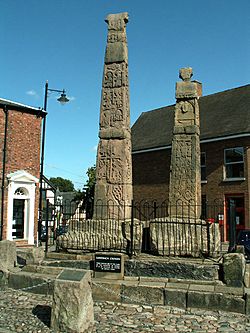Sandbach Crosses facts for kids
Quick facts for kids Sandbach Crosses |
|
|---|---|

Sandbach Crosses
|
|
| OS grid reference | SJ 759 608 |
|
Listed Building – Grade I
|
|
| Designated | 11 August 1950 |
| Reference no. | 1159937 |
| Designated | 30 November 1925 |
| Reference no. | 1011144 |
| Lua error in Module:Location_map at line 420: attempt to index field 'wikibase' (a nil value). | |
The Sandbach Crosses are two amazing stone crosses from the 800s. You can find them in the market square of Sandbach, a town in Cheshire, England. These crosses are very big and have detailed carvings. They are so important that they are protected as a Grade I listed building and a scheduled monument in England.
Contents
What are the Sandbach Crosses?
The Sandbach Crosses are two tall stone crosses. They were made by the Anglo-Saxon people. Experts believe they were carved in the 9th century, which is the 800s. The taller cross was likely made earlier in that century. The slightly smaller one was probably carved around the middle of the 9th century.
Where did the crosses come from?
No one knows exactly where the crosses were first placed. People think they were moved to Sandbach during the Middle Ages. The first time they were written about was in 1585. A man named William Smith described them as "two square crosses of stone, on steps, with certain images and writings thereon graven."
What happened to the crosses?
At some point, the crosses were knocked down. This might have happened during the Protestant Reformation or the English Civil War. Their pieces were scattered far and wide. Some large parts were found many miles away. Smaller pieces were found in different spots around Sandbach.
How were the crosses put back together?
In the early 1800s, people started collecting the pieces. In 1816, a historian named George Ormerod helped put them back together. Today, they stand as two upright stone columns. They are set into a base with three steps.
What do the Sandbach Crosses look like?
The northern cross is the taller one. Its top part is damaged. The southern cross is shorter and has a damaged top from a different cross. Even though they are damaged, we know they were always a pair. The same artist carved both of them.
What carvings can you see?
The crosses have many interesting carvings. You can see religious scenes. There are also small, doll-like heads and different kinds of beasts. The crosses are decorated with beautiful patterns. These include vine-scrolls and complex interlace designs. Some carvings even show dragons.
The Sandbach Crosses in Art and Music
The Sandbach Crosses have inspired artists and musicians.
Crosses in paintings and prints
One of the crosses was painted in a watercolour before it was restored in 1816. This painting was made by William Alexander. Later, John Byrne made an engraving from it. This engraving was published in a book called Britannia Depicta in 1810. You can find copies of these prints in art collections and records offices.
Crosses in music
In 2011, a famous brass band called Foden's Band asked a composer named Andy Scott to write a song for them. He wrote a piece called To the Ancient Crosses. It describes the stone crosses in Sandbach market square. The music is lively and rhythmic.

